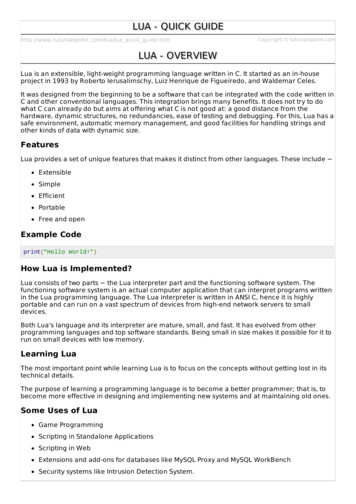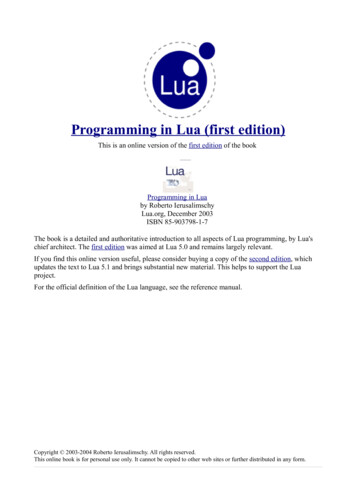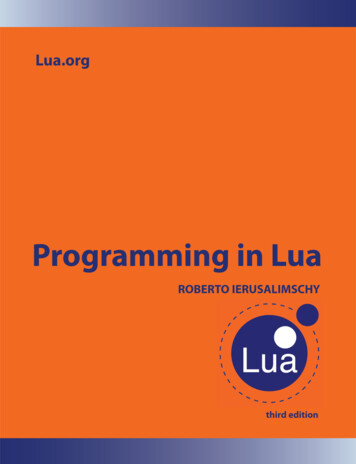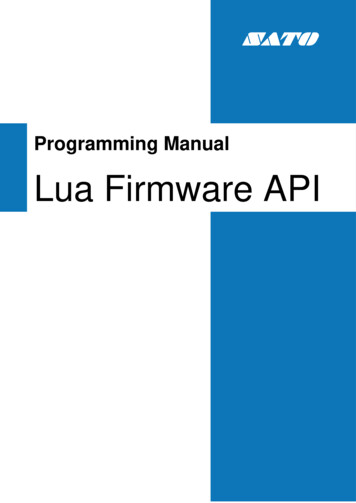
Transcription
LUA - QUICK GUIDEhttp://www.tutorialspoint.com/lua/lua quick guide.htmCopyright tutorialspoint.comLUA - OVERVIEWLua is an extensible, light-weight programming language written in C. It started as an in-houseproject in 1993 by Roberto Ierusalimschy, Luiz Henrique de Figueiredo, and Waldemar Celes.It was designed from the beginning to be a software that can be integrated with the code written inC and other conventional languages. This integration brings many benefits. It does not try to dowhat C can already do but aims at offering what C is not good at: a good distance from thehardware, dynamic structures, no redundancies, ease of testing and debugging. For this, Lua has asafe environment, automatic memory management, and good facilities for handling strings andother kinds of data with dynamic size.FeaturesLua provides a set of unique features that makes it distinct from other languages. These include ExtensibleSimpleEfficientPortableFree and openExample Codeprint("Hello World!")How Lua is Implemented?Lua consists of two parts the Lua interpreter part and the functioning software system. Thefunctioning software system is an actual computer application that can interpret programs writtenin the Lua programming language. The Lua interpreter is written in ANSI C, hence it is highlyportable and can run on a vast spectrum of devices from high-end network servers to smalldevices.Both Lua's language and its interpreter are mature, small, and fast. It has evolved from otherprogramming languages and top software standards. Being small in size makes it possible for it torun on small devices with low memory.Learning LuaThe most important point while learning Lua is to focus on the concepts without getting lost in itstechnical details.The purpose of learning a programming language is to become a better programmer; that is, tobecome more effective in designing and implementing new systems and at maintaining old ones.Some Uses of LuaGame ProgrammingScripting in Standalone ApplicationsScripting in WebExtensions and add-ons for databases like MySQL Proxy and MySQL WorkBenchSecurity systems like Intrusion Detection System.
LUA - ENVIRONMENTTry it Option OnlineWe have set up the Lua Programming environment online, so that you can compileand execute all the available examples online. It gives you confidence in what youare reading and enables you to verify the programs with different options. Feel free tomodify any example and execute it online.Try the following example using our online compiler available at CodingGround#!/usr/local/bin/luaprint("Hello World!")For most of the examples given in this tutorial, you will find a Try it option in ourwebsite code sections at the top right corner that will take you to the online compiler.So just make use of it and enjoy your learning.Local Environment SetupIf you are still willing to set up your environment for Lua programming language, you need thefollowing softwares available on your computer a Text Editor, b The Lua Interpreter, and c LuaCompiler.Text EditorYou need a text editor to type your program. Examples of a few editors include Windows Notepad,OS Edit command, Brief, Epsilon, EMACS, and vim or vi.Name and version of the text editor can vary on different operating systems. For example,Notepad will be used on Windows, and vim or vi can be used on Windows as well as Linux or UNIX.The files you create with your editor are called source files and these files contain the programsource code. The source files for Lua programs are typically named with the extension ".lua".The Lua InterpreterIt is just a small program that enables you to type Lua commands and have them executedimmediately. It stops the execution of a Lua file in case it encounters an error unlike a compilerthat executes fully.The Lua CompilerWhen we extend Lua to other languages/applications, we need a Software Development Kit with acompiler that is compatible with the Lua Application Program Interface.Installation on WindowsThere is a separate IDE named "SciTE" developed for the windows environment which can bedownloaded from http://code.google.com/p/luaforwindows/ download section.Run the downloaded executable to install the Lua IDE.Since its an IDE, you can both create and build the Lua code using the same.In case, you are interested in installing Lua in command line mode, you need to install MinGW orCygwin and then compile and install Lua in windows.Installation on LinuxTo download and build Lua, use the following command
wget http://www.lua.org/ftp/lua-5.2.3.tar.gztar zxf lua-5.2.3.tar.gzcd lua-5.2.3make linux testIn order to install on other platforms like aix, ansi, bsd, generic linux, mingw, posix, solaris byreplacing Linux in make Linux, test with the corresponding platform name.We have a helloWorld.lua, in Lua as follows print("Hello World!")Now, we can build and run a Lua file say helloWorld.lua, by switching to the folder containing thefile using cd, and then using the following command lua helloWorldWe can see the following output.hello worldInstallation on Mac OS XTo build/test Lua in the Mac OS X, use the following command curl -R -O http://www.lua.org/ftp/lua-5.2.3.tar.gztar zxf lua-5.2.3.tar.gzcd lua-5.2.3make macosx testIn certain cases, you may not have installed the Xcode and command line tools. In such cases, youwon’t be able to use the make command. Install Xcode from mac app store. Then go toPreferences of Xcode and then switch to Downloads and install the component named "CommandLine Tools". Once the process is completed, make command will be available to you.It is not mandatory for you to execute the "make macosx test" statement. Even without executingthis command, you can still use Lua in Mac OS X.We have a helloWorld.lua, in Lua, as follows print("Hello World!")Now, we can build and run a Lua file say helloWorld.lua by switching to the folder containing thefile using cd and then using the following command lua helloWorldWe can see the following output hello worldLua IDEAs mentioned earlier, for Windows SciTE, Lua IDE is the default IDE provided by the Lua creatorteam. The alternate IDE available is from ZeroBrane Studio which is available across multipleplatforms like Windows, Mac and Linux.There are also plugins for eclipse that enable the Lua development. Using IDE makes it easier fordevelopment with features like code completion and is highly recommended. The IDE alsoprovides interactive mode programming similar to the command line version of Lua.
LUA - BASIC SYNTAXLet us start creating our first Lua program!First Lua ProgramInteractive Mode ProgrammingLua provides a mode called interactive mode. In this mode, you can type in instructions one afterthe other and get instant results. This can be invoked in the shell by using the lua -i or just the luacommand. Once you type in this, press Enter and the interactive mode will be started as shownbelow. lua -i Lua 5.1.4 Copyright (C) 1994-2008 Lua.org, PUC-Rioquit to end; cd, dir and edit also availableYou can print something using the following statement print("test")Once you press enter, you will get the following output testDefault Mode ProgrammingInvoking the interpreter with a Lua file name parameter begins execution of the file and continuesuntil the script is finished. When the script is finished, the interpreter is no longer active.Let us write a simple Lua program. All Lua files will have extension .lua. So put the following sourcecode in a test.lua file.print("test")Assuming, lua environment is setup correctly, lets run the program using the following code lua test.luaWe will get the following output:testLet's try another way to execute a Lua program. Below is the modified test.lua file #!/usr/local/bin/luaprint("test")Here, we have assumed that you have Lua interpreter available in your /usr/local/bin directory.The first line is ignored by the interpreter if it starts with # sign. Now, try to run this program asfollows chmod a rx test.lua ./test.luaWe will get the following output.test
Let us now see the basic structure of Lua program, so that it will be easy for you to understand thebasic building blocks of the Lua programming language.Tokens in LuaA Lua program consists of various tokens and a token is either a keyword, an identifier, a constant,a string literal, or a symbol. For example, the following Lua statement consists of three tokens io.write("Hello world, from ", VERSION,"!\n")The individual tokens are io.write("Hello world, from ", VERSION,"!\n")CommentsComments are like helping text in your Lua program and they are ignored by the interpreter. Theystart with --[[ and terminates with the characters --]] as shown below --[[ my first program in Lua --]]IdentifiersA Lua identifier is a name used to identify a variable, function, or any other user-defined item. Anidentifier starts with a letter 'A to Z' or 'a to z' or an underscore ' ' followed by zero or more letters,underscores, and digits 0to9.Lua does not allow punctuation characters such as @, , and % within identifiers. Lua is a casesensitive programming language. Thus Manpower and manpower are two different identifiers inLua. Here are some examples of the acceptable identifiers mohdmyname50zaratempabcjmove namea23b9a 123retValKeywordsThe following list shows few of the reserved words in Lua. These reserved words may not be usedas constants or variables or any other identifier ce in LuaA line containing only whitespace, possibly with a comment, is known as a blank line, and a Luainterpreter totally ignores it.Whitespace is the term used in Lua to describe blanks, tabs, newline characters and comments.Whitespace separates one part of a statement from another and enables the interpreter to identifywhere one element in a statement, such as int ends, and the next element begins. Therefore, in
the following statement local ageThere must be at least one whitespace character usuallyaspace between local and age for theinterpreter to be able to distinguish them. On the other hand, in the following statement fruit apples oranges--get the total fruitNo whitespace characters are necessary between fruit and , or between and apples, althoughyou are free to include some if you wish for readability purpose.LUA - VARIABLESA variable is nothing but a name given to a storage area that our programs can manipulate. It canhold different types of values including functions and tables.The name of a variable can be composed of letters, digits, and the underscore character. It mustbegin with either a letter or an underscore. Upper and lowercase letters are distinct because Lua iscase-sensitive. There are eight basic types of values in Lua In Lua, though we don't have variable data types, we have three types based on the scope of thevariable.Global variables All variables are considered global unless explicitly declared as a local.Local variables When the type is specified as local for a variable then its scope is limitedwith the functions inside their scope.Table fields This is a special type of variable that can hold anything except nil includingfunctions.Variable Definition in LuaA variable definition means to tell the interpreter where and how much to create the storage forthe variable. A variable definition have an optional type and contains a list of one or morevariables of that type as follows type variable list;Here, type is optionally local or type specified making it global, and variable list may consist ofone or more identifier names separated by commas. Some valid declarations are shown here locallocallocali, jia,cThe line local i, j both declares and defines the variables i and j; which instructs the interpreter tocreate variables named i, j and limits the scope to be local.Variables can be initialized assignedaninitialvalue in their declaration. The initializer consists of anequal sign followed by a constant expression as follows type variable list value list;Some examples are local d , f 5 ,10 --declaration of d and f as local variables.d , f 5, 10;--declaration of d and f as global variables.d, f 10--[[declaration of d and f as global variables. Here value of f isnil --]]For definition without an initializer variables with static storage duration are implicitly initialized
with nil.Variable Declaration in LuaAs you can see in the above examples, assignments for multiples variables follows a variable listand value list format. In the above example local d, f 5,10 we have d and f in variable list and5 and 10 in values list.Value assigning in Lua takes place like first variable in the variable list with first value in thevalue list and so on. Hence, the value of d is 5 and the value of f is 10.ExampleTry the following example, where variables have been declared at the top, but they have beendefined and initialized inside the main function -- Variable definition:local a, b-- Initializationa 10b 30print("value of a:", a)print("value of b:", b)-- Swapping of variablesb, a a, bprint("value of a:", a)print("value of b:", b)f 70.0/3.0print("value of f", f)When the above code is built and executed, it produces the following result valuevaluevaluevaluevalueofofofofofa: 10b: 30a: 30b: 10f 23.333333333333Lvalues and Rvalues in LuaThere are two kinds of expressions in Lua lvalue Expressions that refer to a memory location is called "lvalue" expression. An lvaluemay appear as either the left-hand or right-hand side of an assignment.rvalue The term rvalue refers to a data value that is stored at some address in memory.An rvalue is an expression that cannot have a value assigned to it, which means an rvaluemay appear on the right-hand side, but not on the left-hand side of an assignment.Variables are lvalues and so may appear on the left-hand side of an assignment. Numeric literalsare rvalues and so may not be assigned and cannot appear on the left-hand side. Following is avalid statement g 20But following is not a valid statement and would generate a build-time error 10 20
In Lua programming language, apart from the above types of assignment, it is possible to havemultiple lvalues and rvalues in the same single statement. It is shown below.g,l 20,30In the above statement, 20 is assigned to g and 30 is assigned to l.LUA - DATA TYPESLua is a dynamically typed language, so the variables don't have types, only the values have types.Values can be stored in variables, passed as parameters and returned as results.In Lua, though we don't have variable data types, but we have types for the values. The list of datatypes for values are given below.Value TypeDescriptionnilUsed to differentiate the value from having some data or nonil data.booleanIncludes true and false as values. Generally used for condition checking.numberRepresents realdoubleprecisionfloatingpoint numbers.stringRepresents array of characters.functionRepresents a method that is written in C or Lua.userdataRepresents arbitrary C data.threadRepresents independent threads of execution and it is used to implementcoroutines.tableRepresent ordinary arrays, symbol tables, sets, records, graphs, trees, etc.,and implements associative arrays. It can hold any value exceptnil.Type FunctionIn Lua, there is a function called 'type' that enables us to know the type of the variable. Someexamples are given in the following code.print(type("What is my type"))t 10-- pe(type(ABC)))-- -- -- -- -- -- numberbooleanfunctionfunctionnilstringWhen you build and execute the above program, it produces the following result on Linux stringnumberbooleanfunctionfunctionnilstringBy default, all the variables will point to nil until they are assigned a value or initialized. In Lua, zeroand empty strings are considered to be true in case of condition checks. Hence you have to be
careful when using Boolean operations. We will know more using these types in the next chapters.LUA - OPERATORSAn operator is a symbol that tells the interpreter to perform specific mathematical or logicalmanipulations. Lua language is rich in built-in operators and provides the following type ofoperators Arithmetic OperatorsRelational OperatorsLogical OperatorsMisc OperatorsThis tutorial will explain the arithmetic, relational, logical, and other miscellaneous operators oneby one.Arithmetic OperatorsFollowing table shows all the arithmetic operators supported by Lua language. Assume variable Aholds 10 and variable B holds 20 then Show ExamplesOperatorDescriptionExample Adds two operandsA B will give 30-Subtracts second operand from the firstA - B will give -10*Multiply both operandsA * B will give 200/Divide numerator by de-numeratorB / A will give 2%Modulus Operator and remainder of after aninteger divisionB % A will give 0 Exponent Operator takes the exponentsA 2 will give 100-Unary - operator acts as negation-A will give -10Relational OperatorsFollowing table shows all the relational operators supported by Lua language. Assume variable Aholds 10 and variable B holds 20 then Show ExamplesOperatorDescriptionExample Checks if the value of two operands are equal ornot, if yes then condition becomes true.A B is not true. Checks if the value of two operands are equal ornot, if values are not equal then condition becomestrue.A B is true. Checks if the value of left operand is greater thanthe value of right operand, if yes then conditionbecomes true.A B is not true. Checks if the value of left operand is less than theA B is true.
value of right operand, if yes then conditionbecomes true. Checks if the value of left operand is greater thanor equal to the value of right operand, if yes thencondition becomes true.A B is not true. Checks if the value of left operand is less than orequal to the value of right operand, if yes thencondition becomes true.A B is true.Logical OperatorsFollowing table shows all the logical operators supported by Lua language. Assume variable Aholds true and variable B holds false then Show ExamplesOperatorDescriptionExampleandCalled Logical AND operator. If both the operandsare non zero then condition becomes true.AandB is false.orCalled Logical OR Operator. If any of the twooperands is non zero then condition becomes true.AorB is true.notCalled Logical NOT Operator. Use to reverses thelogical state of its operand. If a condition is truethen Logical NOT operator will make false.!AandB is true.Misc OperatorsMiscellaneous operators supported by Lua Language include concatenation and length.Show ExamplesOperatorDescriptionExample.Concatenates two strings.a.b where a is "Hello " and bis "World", will return "HelloWorld".#An unary operator that return the length of the astring or a table.#"Hello" will return 5Operators Precedence in LuaOperator precedence determines the grouping of terms in an expression. This affects how anexpression is evaluated. Certain operators have higher precedence than others; for example, themultiplication operator has higher precedence than the addition operator For example, x 7 3 * 2; Here x is assigned 13, not 20 because operator * has higherprecedence than + so it first get multiplied with 3*2 and then adds into 7.Here, operators with the highest precedence appear at the top of the table, those with the lowestappear at the bottom. Within an expression, higher precedence operators will be evaluated first.Show Examples
CategoryOperatorAssociativityUnarynot # -Right to leftConcatenation.Right to leftMultiplicative*/%Left to rightAdditive -Left to rightRelational Left to rightEquality Left to rightLogical ANDandLeft to rightLogical ORorLeft to rightLUA - LOOPSThere may be a situation when you need to execute a block of code several number of times. Ingeneral, statements are executed sequentially the first statement in a function is executed first,followed by the second, and so on.Programming languages provide various control structures that allow for more complicatedexecution paths.A loop statement allows us to execute a statement or group of statements multiple times.Following is the general form of a loop statement in most of the programming languages Lua provides the following types of loops to handle looping requirements.Loop TypeDescriptionwhile loopRepeats a statement or group of statements while a givencondition is true. It tests the condition before executing the loopbody.for loopExecutes a sequence of statements multiple times andabbreviates the code that manages the loop variable.
repeat.until loopRepeats the operation of group of statements till the untilcondition is met.nested loopsYou can use one or more loop inside any another while, for ordo.while loop.Loop Control StatementLoop control statement changes execution from its normal sequence. When execution leaves ascope, all automatic objects that were created in that scope are destroyed.Lua supports the following control statements.Control StatementDescriptionbreak statementTerminates the loop and transfers execution to the statementimmediately following the loop or switch.The Infinite LoopA loop becomes infinite loop if a condition never becomes false. The while loop is often used forthis purpose. Since we directly give true for the condition, it keeps executing forever. We can usethe break statement to break this loop.while( true )doprint("This loop will run forever.")endLUA - DECISION MAKINGDecision making structures require that the programmer specifies one or more conditions to beevaluated or tested by the program, along with a statement or statements to be executed, if thecondition is determined to be true, and optionally, other statements to be executed if the conditionis determined to be false.Following is the general form of a typical decision making structure found in most of theprogramming languages
Lua programming language assumes any combination of Boolean true and non-nil values astrue, and if it is either boolean false or nil, then it is assumed as false value. It is to be noted thatin Lua, zero will be considered as true.Lua programming language provides the following types of decision making statements.StatementDescriptionif statementAn if statement consists of a boolean expression followed by oneor more statements.if.else statementAn if statement can be followed by an optional else statement,which executes when the boolean expression is false.nested if statementsYou can use one if or else if statement inside another if or else ifstatements.LUA - FUNCTIONSA function is a group of statements that together perform a task. You can divide up your code intoseparate functions. How you divide up your code among different functions is up to you, butlogically the division usually unique, is so each function performs a specific task.The Lua language provides numerous built-in methods that your program can call. For example,method print to print the argument passed as input in console.A function is known with various names like a method or a sub-routine or a procedure etc.Defining a FunctionThe general form of a method definition in Lua programming language is as follows optional function scope function function name( argument1, argument2, argument3.,argumentn)function bodyreturn result params comma separatedendA method definition in Lua programming language consists of a method header and a methodbody. Here are all the parts of a method Optional Function Scope You can use keyword local to limit the scope of the function orignore the scope section, which will make it a global function.Function Name This is the actual name of the function. The function name and theparameter list together constitute the function signature.Arguments An argument is like a placeholder. When a function is invoked, you pass avalue to the argument. This value is referred to as the actual parameter or argument. Theparameter list refers to the type, order, and number of the arguments of a method.Arguments are optional; that is, a method may contain no argument.Function Body The method body contains a collection of statements that define what themethod does.Return In Lua, it is possible to return multiple values by following the return keyword withthe comma separated return values.ExampleFollowing is the source code for a function called max. This function takes two parameters num1and num2 and returns the maximum between the two
--[[ function returning the max between two numbers --]]function max(num1, num2)if (num1 num2) thenresult num1;elseresult num2;endreturn result;endFunction ArgumentsIf a function is to use arguments, it must declare the variables that accept the values of thearguments. These variables are called the formal parameters of the function.The formal parameters behave like other local variables inside the function and are created uponentry into the function and destroyed upon exit.Calling a FunctionWhile creating a Lua function, you give a definition of what the function has to do. To use amethod, you will have to call that function to perform the defined task.When a program calls a function, program control is transferred to the called function. A calledfunction performs the defined task and when its return statement is executed or when its function'send is reached, it returns program control back to the main program.To call a method, you simply need to pass the required parameters along with the method nameand if the method returns a value, then you can store the returned value. For example function max(num1, num2)if (num1 num2) thenresult num1;elseresult num2;endreturn result;end-- calling a functionprint("The maximum of the two numbers is ",max(10,4))print("The maximum of the two numbers is ",max(5,6))When we run the above code, we will get the following output.The maximum of the two numbers isThe maximum of the two numbers is106Assigning and Passing FunctionsIn Lua, we can assign the function to variables and also can pass them as parameters of anotherfunction. Here is a simple example for assigning and passing a function as parameter in Lua.myprint function(param)print("This is my print function endfunction add(num1,num2,functionPrint)result num1 num2functionPrint(result)end##",param,"##")
myprint(10)add(2,5,myprint)When we run the above code, we will get the following output.This is my print function This is my print function -## 10 #### 7 ##Function with Variable ArgumentIt is possible to create functions with variable arguments in Lua using '.' as its parameter. We canget a grasp of this by seeing an example in which the function will return the average and it cantake variable arguments.function average(.)result 0local arg {.}for i,v in ipairs(arg) doresult result vendreturn result/#argendprint("The average is",average(10,5,3,4,5,6))When we run the above code, we will get the following output.The average is 5.5LUA - STRINGSString is a sequence of characters as well as control characters like form feed. String can beinitialized with three forms which includes Characters between single quotesCharacters between double quotesCharacters between [[ and ]]An example for the above three forms are shown below.string1 "Lua"print("\"String 1 is\"",string1)string2 'Tutorial'print("String 2 is",string2)string3 [["Lua Tutorial"]]print("String 3 is",string3)When we run the above program, we will get the following output."String 1" is LuaString 2 is TutorialString 3 is "Lua Tutorial"Escape sequence characters are used in string to change the normal interpretation of characters.For example, to print double inverted commas "", we have used \" in the above example. Theescape sequence and its use is listed below in the table.Escape SequenceUse\aBell
\bBackspace\fFormfeed\nNew line\rCarriage return\tTab\vVertical tab\\Backslash\"Double quotes\'Single quotes\[Left square bracket\]Right square bracketString ManipulationLua supports string to manipulate strings S.N.1Method & Purposestring.upperargumentReturns a capitalized representation of the argument.2string.lowerargumentReturns a lower case representation of the StringReturns a string by replacing occurrences of findString with ,optionalStartIndex,optionalEndIndexReturns the start index and end index of the findString in the main string and nil if notfound.5string.reverseargReturns a string by reversing the characters of the passed string.6string.format.Returns a formatted string.7
7string.chararg and string.byteargReturns internal numeric and character representations of input argument.8string.lenargReturns a length of the passed string.9string.repstring, n)Returns a string by repeating the same string n number times.10.Thus operator concatenates two strings.Now, let's dive into a few examples to exactly see how these string manipulation functions behave.Case ManipulationA sample code for manipulating the strings to upper and lower case is given below.string1 er(string1))When we run the above program, we will get the following output.LUAluaReplacing a SubstringA sample code for replacing occurrences of one string with another is given below.string "Lua Tutorial"-- replacing stringsnewstring e new string is",newstring)When we run the above program, we will get the following output.The new string is Lua LanguageFinding and ReversingA sample code for finding the index of substring and reversing string is given below.string "Lua Tutorial"-- replacing edString string.reverse(string)print("The new string is",reversedString)
When w
basic building blocks of the Lua programming language. Tokens in Lua A Lua program consists of various tokens and a token is either a keyword, an identifier, a constant, a string literal, or a symbol. For example, the following Lua statement consists of three tokens io.write("Hello world, from ",_VERSION,"!\n") The individual tokens are .










